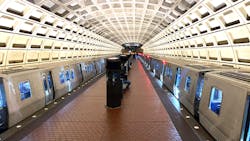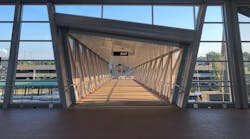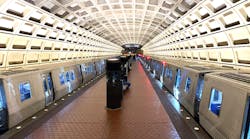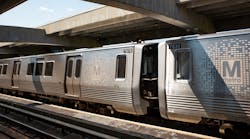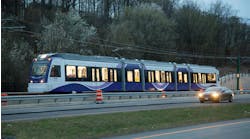More 7000 Series railcars will return to WMATA after WMSC clears return to service plan
The Washington Metrorail Safety Commission (WMSC) “has no technical objections” to Washington Metropolitan Area Transit Authority’s (WMATA) more recent Return to Service Plan that will see more 7000 series railcars on WMATA’s Metrorail system.
There are no limits to the number of 7000 series railcars that can be in operation on Metrorail daily and cars will be qualified for service every four days. This will then be stepped up to inspecting at seven-day intervals.
Initially, WMATA was allowed to return eight 7000 series trains to service with nightly inspections, followed by the next phase of which allowed up to 20 trains with a four-day inspection interval to return to service. WMATA reports that since June, 694 rail cars have been inspected more than 72,000 times and have operated more than 3 million miles.
Axle press tonnage
This iteration of the Return to Service Plan differentiates between 7000 series railcars with high press tonnage axles (axles that have been pressed to a specification of 65-96 tons) and low press tonnage axles (axles that have been pressed to 55-65 tons). Cars with high press tonnage axles will enter service on all Metrorail lines and up to 80 low press tonnage axle cars entering service on the Red, Yellow and Green lines. WMATA will modify its active railcar report to indicate whether a car is a high or low press tonnage vehicle.
This matters as the authority continues to work with investigators on the root cause of the derailment in October 2021 that resulted in the 7000 series railcars being pulled from service. Part of the accident investigation into why the train experienced wheel migration is focused on engineering elements, such as vehicle/track interaction. According to an Oct. 13 memorandum WMATA Interim Vice President and Chief Mechanical Officer Shushil Ramnaress, the main difference between the Blue, Orange and Silver lines is the existence of two curves with tighter-than-average radius between Metro Center and McPherson Square. These curves are equipped with restraining rail, which is used to prevent wheel climb.
WMATA personnel “considered general elements that could cause wheel migration: press tonnage; interference fit and surface finish, wheel climb and restraining rail; and frog and interlocking conditions. Metro does not propose that any of these elements, in isolation, are the root cause of the October 12, 2021 derailment.”
The most recent Return to Service plan would allow cars with low press tonnage axles to be used on all Metrorail lines in future phases if the data supports their use.
Impact on Silver Line extension
The return of additional 7000 series railcars will support the planned opening of the Silver Line extension before Thanksgiving. Additional railcar availability, as well as finalization of the safety certification report of the extension were required before a definitive date to open the line for service could be set.
“With this approval and close collaboration on the Silver Line extension safety report, Metro will be able to set an opening date in the near future,” said General Manager and Chief Executive Officer Randy Clarke. “I want to thank the Safety Commission for their collaboration on reaching this important safety milestone, so we have a clear path forward.”
“After brokering productive discussions with WMATA and Metro Safety Commission last week and over the weekend, we are pleased to see a plan that will allow more 7000 series cars back on the tracks ahead of the busy holiday season. This plan, if carefully followed, will allow the safe and timely opening of the Silver Line to Dulles by Thanksgiving, assuming the remaining routine matters are handled diligently. Once open, the Silver Line will alleviate road congestion and enhance access to economic, entertainment, and travel opportunities in the region—all without compromising rider safety. We look forward to continuing to work with WMATA and the Metro Safety Commission to provide oversight over the careful execution of this plan,” U.S. Sens. Mark R. Warner and Tim Kaine (both D-VA) noted in a joint statement.
“Metro leaders welcomed the concurrence of the Washington Metrorail Safety Commission to gradually return all 7000-series railcars to passenger service,” said WMATA Board Chair Paul C. Smedberg. “This is a win for customers, and we are grateful to Senators Warner and Kaine for their leadership to reach an agreement that will safely return more 7Ks to service.”

Mischa Wanek-Libman | Group Editorial Director
Mischa Wanek-Libman is director of communications with Transdev North America. She has more than 20 years of experience working in the transportation industry covering construction projects, engineering challenges, transit and rail operations and best practices.
Wanek-Libman has held top editorial positions at freight rail and public transportation business-to-business publications including as editor-in-chief and editorial director of Mass Transit from 2018-2024. She has been recognized for editorial excellence through her individual work, as well as for collaborative content.
She is an active member of the American Public Transportation Association's Marketing and Communications Committee and served 14 years as a Board Observer on the National Railroad Construction and Maintenance Association (NRC) Board of Directors.
She is a graduate of Drake University in Des Moines, Iowa, where she earned a Bachelor of Arts degree in Journalism and Mass Communication.
